Health Care Access & Coverage
News
Who Benefits Most From Health Care Insurers’ Mergers?
A Penn-SiriusXM Radio Show Explores The Controversy

In a panel discussion on Penn’s Wharton/SiriusXM radio channel Wharton Professor and LDI Senior Fellow Robert Town discusses the complexities of determining potential antitrust violations in state health insurance markets.
The two proposed health care insurance mega-mergers currently under review have drawn national battle lines over whether such consolidation would be more likely to improve care and price or negotiating clout and profit margins.
The Justice Department, Federal Trade Commission and state insurance regulators are examining Aetna’s planned $37 billion acquisition of Humana and Anthem’s planned $54 billion acquisition for Cigna. If both mergers are approved, the country’s list of largest health insurers would shrink from five to three with the two newly merged entities covering about 86 million people.
Economies of scale
In recent Congressional testimony, the CEOs of Aetna and Anthem said the mergers would use economies of scale to “improve the quality of care and overall affordability.”

Immediate past president of the Wharton Health Care Management Alumni Association Jeff Voigt hosts the Wharton SiriusXM Business of Health Care show.
But the American Hospital Association, American Medical Association and a coalition of consumer advocacy groups have charged that such mergers create monopolistic market conditions likely to achieve the opposite.
Who’s right?
The University of Pennsylvania’s Wharton/SiriusXM radio’s “The Business of Health Care” program recently brought together a panel of health economics experts to discuss the question, including one Johns Hopkins and two Penn health economists and a former U.S. Justice Department Antitrust Division counsel.
Show host Jeff Voigt, MPH, immediate past president of the Wharton Health Care Management Alumni Association (WHCMAA), kicked things off by asking if there is scientific evidence that the economies of scale created by mergers ultimately lead to lower premiums?
‘Not a lot of evidence’
“A variety of economists, including myself, have researched this question,” said Wharton School health care economist Amanda Starc, PhD. “We tend to find that more consolidation of health insurers leads to higher premiums and there’s not a lot of evidence of any savings potentially generated by these mergers through economies of scale.”

Wharton School health economist and LDI Senior Fellow Amanda Starc said there’s ‘not a lot of evidence’ that insurance company mergers generate savings or lower premium prices.
Her fellow Wharton health economist Robert Town, PhD, concurred. “In general in the insurance sector,” he explained, “the economies of scale are exhausted at relatively low enrollment. That’s what you see if you look backwards at past data. Perhaps in this new world of health care reform there could be new economies of scale through population health management but that’s just a hypothesis that may not be true. So I think we should be concerned.”
Bradley Herring, PhD, Director of Johns Hopkins PhD Concentration in Health Economics and Policy, said “there is no evidence to suggest that consolidation will benefit consumers. The underlying story is that whatever cost savings insurers realize — whether through negotiated lower prices or reduction of administration costs via IT innovations — will likely not be passed along to consumers but rather retained as higher profits.”
“The important question,” said former Justice Department Antitrust Division Counsel George Slover, JD,” is not just ‘are these benefits of a merger real? Are they enough? Do you really need the merger in order to get those benefits?’ And if you don’t need the merger to get those benefits, then they really don’t act as a counterweight to all of the harms that could result (from the merger).”
Complex issues
While the panel’s general consensus was one of skepticism about the merger, many of their comments underscored how the overall picture is not nearly as simple or black or white as sometimes portrayed in the popular press or by the current crop of lobbyists who are paid to influence federal regulators’ decision. For instance, hospital systems have been consolidating at a frantic pace, growing bigger both in physical size and negotiating clout. Insurance companies’ desire to consolidate and achieve “clout parity” is an understandable dynamic whose ultimate consequences — good or bad — are not now knowable.
Slover, who is also Senior Counsel at Consumers Union in Washington, noted that a major merger-related concern of the organization is maintaining the quality of patient care because “a too-concentrated insurance industry is going to result in a degradation of care provided by the providers who are pushed to reduce their costs.” Other analysts have pointed out that the negotiating clout of a heavily consolidated health insurance industry might ultimately be powerful enough to significantly degrade physician fees and hospitalists’ salaries as well.
Providers vs. insurers
“Antitrust authorities in recent years have been concerned with the increasing consolidation in health care provider markets,” said Starc. “So, you might think that instead of having a small number of providers negotiating with a large number of insurers, it might be better to have a small number of buyers and a small number of sellers negotiating with each other. That might be more effective at holding down some of the provider prices.”
“But,” she continued, “if we successfully hold down those provider prices, what happens to consumers? Are those savings passed through in the form of lower premiums or not? As Bradley Herring has mentioned, the evidence suggests it’s unlikely any savings would be passed along to the consumer.”
Another issue of complexity is that the 50 individual state insurance markets are actually a tangle of separate layers of insurance markets. Different insurers have different market shares in a manner that makes it difficult to parse out exactly what constitutes a true monopoly in any given region.
‘A lot of different markets’
“There are a lot of different overlapping markets in health insurance, including Medicare Part D, Medicare Advantage, the small group market, the large group market and the exchange market,” said Town. “All of these are different and you can easily have a big player in one market who is a small player in another parallel market and vice versa in the same region. So, sorting out what the competitive effects is not going to be easy.”
Show host Voigt asked about the effectiveness of the last regulatory move aimed at preventing higher premiums — the so-called “medical loss ratio” rules that require insurers to both pay out a certain percentage of their total revenue in claims and rebate overages in revenue to consumers.
“The idea behind that is that we want insurance to be something close to actuarially fair to create a market that both insurers and consumers want to buy into,” Starc explained. “But in practice the medical loss ratio has created an awkward sort of profit ceiling and has also created incentives for insurers to engage in accounting tricks in terms of what counts as a ‘medical cost’ or not. Overall, it’s certainly not more effective than competition for controlling prices.”